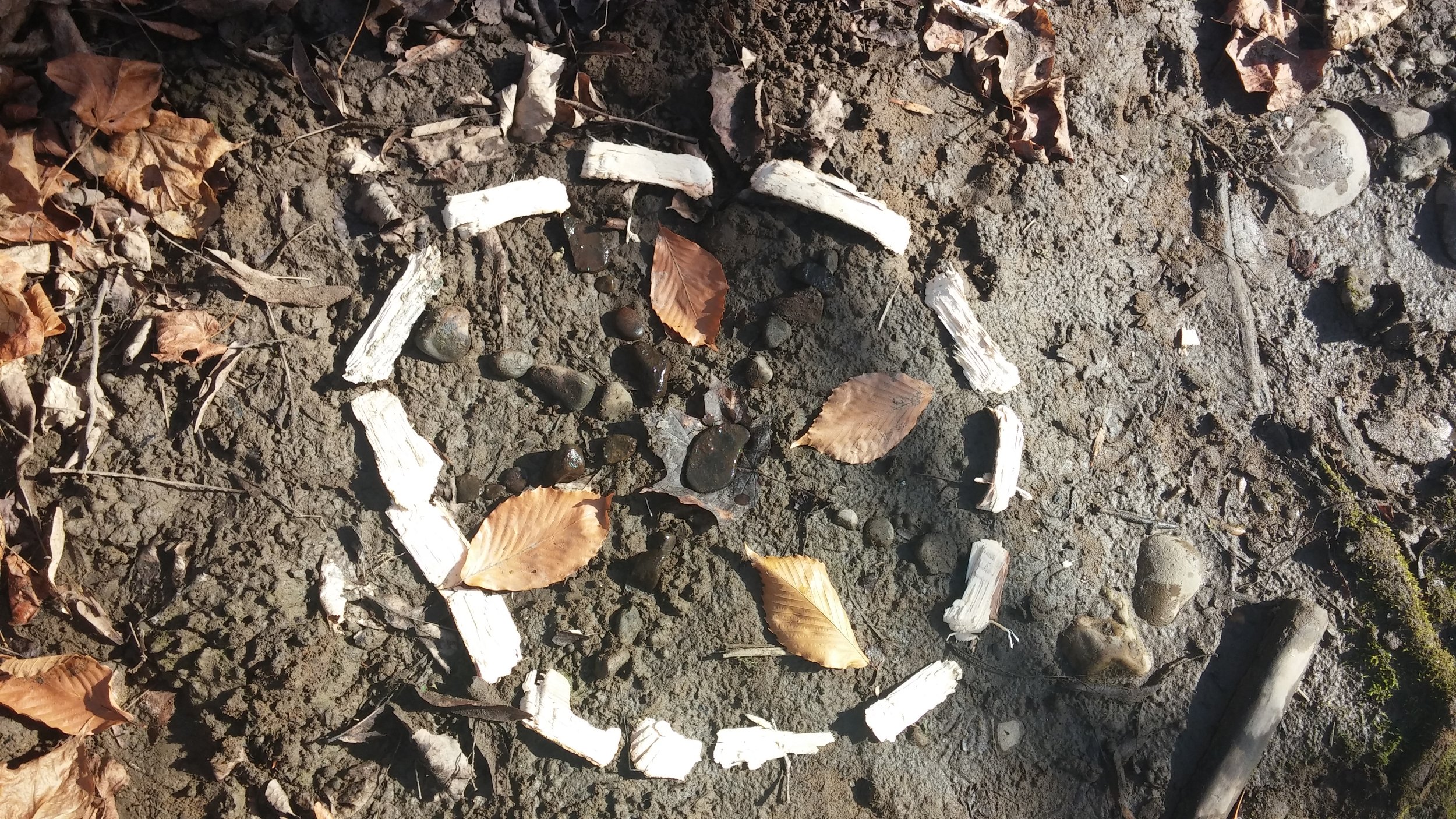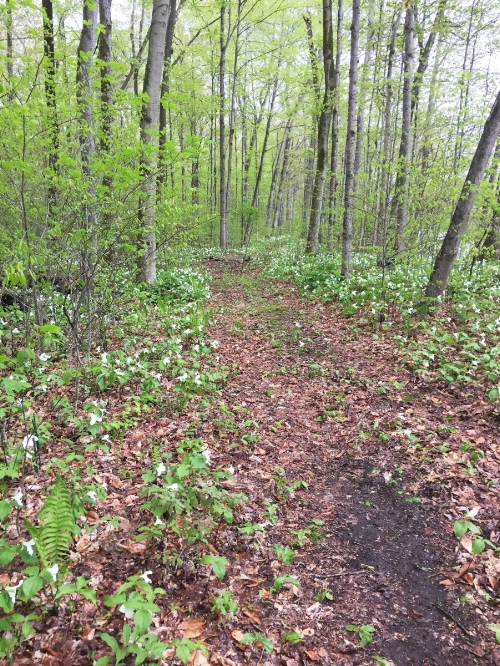
Living in Tick Country
Fall is truly upon us now and this is one of the times of the year that ticks seem to be most prevalent in the Northeast/Adirondack foothills. Spring is the other season when they're highly active. During the summer when we may popularly think of ticks being about, they are less of a problem because they don't thrive in hot or dry conditions. Ticks thrive in cold, damp conditions and although they can be present during both winter and summer, they are far more active at spring and fall.
For me this means that I become more vigilant and discerning when I’m out walking, hiking, or wildcrafting. Ticks are found most abundantly in tall grass, brush-like areas such as where you would find goldenrod growing, and in leaf litter on the forest floor. Any place where you may be standing or walking where the vegetation is high enough that it touches your ankles or legs and part of your clothing or person, including hair, is a place where there could potentially be ticks. I know, it’s crazy!
Herbalism and Decolonization
Working with plants, their healing potential, and their influence on human health has opened me to a relationship with nature, place, and herbs that goes far beyond the simple and effective uses of plants as medicines. Plant medicine and herbalism as a tradition belongs to more than just our contemporary impulse to identify, name, label, and cure with “this herb for that”, although this is often the initial spell that so cleverly draws us into the long, lost woods where our ancestors once foraged for talking roots carrying handwoven baskets into places with mythic names and hollow trees that open to the Underworld.
The plants dazzle and enchant us
Even with hardened, colonial hearts we are inspelled.
They have not lost their magick
We follow them back to ours.
Invasive Plants and Preaching to the Choir
I am often asked my opinion on how to best address the ongoing trespasses of invasive plant species. What should be done about invasive plants? But I contend that this is an invasive question and would be better reformed to request and express a curiosity about how to actualize and generate healthy plant and ecosystem communities that are in coherent and non-hostile relationship with the past, present, and future conditions of our local bioregions. Living at the edge of the Adirondack Park where there are all-out declarations of war against certain invasive species calling for the use of heavy artillery herbicides with, seemingly, little attention to the geographical, land-centered history of place, I feel these attacks are a bit short-sighted. To be clear, I’m not saying that it’s ok to just allow invasive species to take over. That would be as equally short-sighted. What I speak of is between, within, and both.
Ephemeral Encounters
The steep darkness of a silent, cold Winter can only sustain such strength of contraction for so long. As the wheel of the year turns, the density that has folded in upon itself for months must finally cleave its frozen, shadowed bonds and here, in the Northeastern woodlands, Spring rises from the release of natures iced embrace with an offering of warmth for the hearts and souls of the people.
Once upon a time these awakenings were well marked by magic and ritual as our clans and communities knew that if place and time were to be an instrument for conscious creation, it must be held by the storied, dreaming, dance and play of those that waited and watched as new life teemed upon the surface.
"Today's Tea" Blends
Tea is probably the most ancient of herbal preparation known to humankind. For all of my years of practice making herbal preparations, I still find the medicine in a cup of tea to be strong and effective in many ways. Just the simple act of making tea can create much needed restorative moments of presence within the fabric of our busy lives.
Tea blending is an art, practice, and skill that anyone can learn. I don't follow any steadfast rules, but instead, use my intuition and foundational knowledge of plant properties, taste, and the overall effect I'm hoping the tea will convey. This means that I basically just go into my pantry where my dried herbs are stored and grab whichever jars I'm in the mood for. Some days there is some central issue I want to address with my tea such as an upset stomach, joint pain, winter blues, or a cold/runny nose/cough. The number of herbs required is also dependent on the day and can range from simply one herb or several.
Sacred Plant ID
I have spent more than two decades now studying plants and their medicines. These years have been a great journey that has had many utterly beautiful gifts as well as many intense and growth generating challenges. Every person’s experience and contact with the green nations is unique and for me it is always a sacred activity. By sacred I mean that I have found the beauty, character, qualities, and healing virtues of plants, as well as the whole of nature, to be a dimension of divine creation that, if we are reverent and conscious of, we can become connected with. It has been my experience that with patience, practice, devotion and a heart-centered focus we can begin to perceive and become aware of our innate capacity to understand a meaning and significance of what would normally be invisible or disregarded.
Hawthorne~The Faery Tree
The Hawthorne tree, Crataegus spp., is one of the most ennobled trees in the Old Ways of Ireland and the Celtic nations and, when combined with Oak and Ash, forms the sacred tree triad. These three trees each indicate the presence of the Sidhe(Shee) or Faery race. The Hawthorne, specifically, demarcates a bridge or barrier into the faery world. It can be a bridge for those that are prepared for the journey or a barrier for those who have not yet developed the skills required for travel into other realms. It has been often warned that one should not unwittingly fall asleep beneath a Hawthorne for fear of the uninitiated crossing into the otherworld and not knowing how to get back. It is a small tree or large shrub although I've seen some enormous full tree sized Hawthornes. They seem to like to grow in groves and often there will be several in a cluster and, where I live, they shelter many white-tail deer families beneath their thorny branches.
The Four Elements and Traditional Western Herbalism
The four elements are the base fabrics and energetic forms with which many holistic herbal healing traditions enrooted their systems and methods including Traditional Western Herbalism. There are many variations of elemental theory to be found throughout history within almost all healing traditions across the world. Ayurveda in India, Chinese traditional medicine, Greek medicine and the European alchemical tradition are just some of the ancient methodologies that incorporate these elemental energies in various arrangements. In ancient Europe, the definition, identification and origin of the four element theory is attributed to Greek philosopher from Sicily, Empedocles about 440 B.C. and was later expounded upon by Aristotle. Modern herbalism was most notable influenced by elemental philosophy by the Swiss physician Paracelsus who based his medical theory on this canon.
Keeping Hearth~The Practice of Sacred Householding
"HOUSEHOLDER-One who inhabits a house on the Earth while living with God in her heart, or the Goddess in her soul. A difficult sadhana(spiritual practice). In India, one on a spiritual path would be a householder for the first part of the adult life and then become devoted to a solitary practice during the latter years. Sometimes the world catches us though." ~Jeannine Parvati in Hygieia, A Woman's Herbal
I've spent my entire adult life as what can be called a "householder". This is a term that, to me, means that part of the work of my soul on Earth is the work of running a household and all that pertains to it. This type of work, or what one might call "spiritual path", is probably the most challenging and wrought with pitfalls that will test the tinder of the strongest of hearts. The challenges, however, are great teachers that, when mastered, cultivate great reward. I've not always been conscious and grateful for this form of service because I've often found it to be an oppressive burden placed upon me by conscription from a variety of internal and external forces. One being my dearest and most formidable complex of perfectionism along with a solid, well-embedded pattern of OCD. I also inherited my Italian immigrant grandparents motto of toxic shame that still rings in my ears to this day, "We may be poor but we don't have to be dirty," so clean, clean, clean.
Herbal Medicine and the Meeting of the Worlds
The roots of herbal medicine stretch far and wide throughout the matrix of human history, absorbing the essential nutrients of time during its journey within the narrative of the Earth. It’s a tale of wildness, creation, and co-evolutionary alliances that has engaged us in the twining of the original conversation of the elements that continues its atomic exchange and feeds and nourishes the fire at the hearth of the soul of the world. Our ongoing collaboration with the plants is coursing forward on the genetic scrolls of our ancestors and must be consistently renewed and renegotiated in order to keep this tradition alive.
Bioregional Herbalism ~ An Introduction To Ecological Relationship & Place-Based Practice
Bioregionalism is a word that was originally termed by activist Peter Berg in the early 1970’s, the height of many counterculture movements across the United States. He lived in San Francisco where a multitude of forces often gathered in various forms of protest as a reaction to a mainstream culture that was dominated by the ever-present paradigms of war and competition. Peter Berg died in July of 2011, but left a legacy and vision that lives on within many of today’s social justice and environmental movements.
Making Flower Waters
Making your own hydrosol or flower water is a simple, economical and ecologically sound method of extracting the scent and medicine from flowers. Flower waters are also an excellent alternative to essential oils that are expensive and have serious environmental consequences. Although I love essential oils and they are undeniably powerful medicine, they have become highly commericalized leading to the overharvesting of wild plants and promoting large scale agri-farming and monocropping of flowers to meet market demands. In an article written by Jen Landry, Dipl. ABT (NCCAOM), that recently appeared in United Plant Savers Journal, to make one pound of essential oil it requires 50-60lbs. of Eucalyptus, 200-250 lbs of Lavender and 5,000-10,000lbs. of Rose blossoms. The copious use of essential oils as a suitable remedies for a vast array of conditions and illnesses is not sustainable and in most cases unecessary. I do think it's important to recognize, however, that essential oils are being used in place of harsh chemical cleaners and synthetic fragrances. This is a step in the right direction when we consider the grave and hazardous results to that the use of such substances as produced for the planet and people. But, as to be expected, the popularity of essential oils and the recognition of their benefits has lead to superflous over-consumption. There are many alternatives to essential oils that are as equally effective and far more responsible.
Vitex For Female Health and Hormonal Balance
Vitex agnus-castus, also called ChasteTree is a shrub in the Verbena family and is native to the Mediterranean area of the world. It loves growing in wet places, along river beds, and other wet areas, but has been cultivated throughout Europe and used medicinally worldwide. I can attest to its desire for water as I have been growing one in a pot for a couple of years. The Northeastern climate in the United States is not conducive to garden cultivation of Mediterranean plants so I move it back and forth from my porch to my living room seasonally. It definitely requires daily watering or the leaves will wilt. The dried fruits are the part that is used medicinally and they look like dark purple pepper seeds when dried. The seeds can also be used a spice and have a slight peppery, warming flavor. Another common name for Vitex is ‘hemp tree’, I’m assuming this is because its leaves resemble cannabis leaves being palmate with five separate leaves connected at the center.
Sacred Tea Ceremony
Many of us think of the Japanese tradition when we hear “Tea Ceremony” and they definitely have one of the worlds most beautiful and sacred ways of making tea a healing practice. Tea ceremonies have been done in different ways in many other cultures also. The English are famous for their afternoon teatime and a tea culture exists in many other countries where tea making is sometimes ritualized and sometimes just a part of daily life as is our American coffee culture. Many ‘hip’ communities in the United States now have “tea rooms” where people can gather and drink tea together while relaxing and visiting. There is even an “American Tea Ceremony” now that has been adapted from the Japanese version.
Aralia Nudicaulis ~The Wild Ways of American Sarsaparilla
Botanical Name: Aralia Nudicaulis. A member of the Araliaceae or Ginseng family
Status: Native to North American in boreal forests. It is found beneath hardwoods in rich soil.
Common names: Wild Sarsparilla, American Sarsparilla, Small Spikenard, False Sarsparilla, Wild Licorice, Rabbit Root
Description: A perennial that grows in the woods of the Northern United States and Canada. The leaf stalk grows up to 18” tall with compound leaves that branch out into 3 groups of 5 each. The flower is an umbel that comes up beneath the leaves in groups of 3. The leaves die back in the summer leaving the flowers to ripen into purplish black berries. The root is gathered although all parts of the plant can be used. The main root grows vertically down just a few inches but there are secondary runners that grow horizontally. New plants emerge from these underground rhizomes forming interconnected colonies. Gather in the Spring or Fall.
Muscle-Skeletal Pain and the Gut Connection
Pain is a word that is used to describe a wide range of experiences that all humans encounter. There are many different patterns that occur throughout life that are considered to be painful and, ‘pain’ itself is not a disease, illness or syndrome but is a symptom of many. In the most literal sense, pain refers to any physical sensation that is unpleasant and causes one to take evasive action. It is also a signal that communicates to our brains that we must become aware of some dysfunction and make the necessary changes to make it stop. As herbalist and bodywork Tammi Sweet says, "Pain is a signal to change your behavior". That can mean many things including lifestyle and diet, but also mental and emotional behaviors, attitudes and thought processes. Evasive action is not always the most appropriate either. Changing our behavior can mean to stop evading something and explore more deeply into the core of any issue or injury in search of hidden or repressed feelings or matters. Sometimes what is called for is for us to actually move more deeply into ourselves and embody our unique Earthly form more completely. I taught Yoga for many years and always encouraged my students to find their 'edge' where they were not in pain but were stretching themselves, gently, beyond their comfort zone. This requires that we move our awareness into tight and sometimes scary places and re-associate or, some would say, occupy places that we may rather ignore.
The Medicine of Elecampane
The first day of spring is coming up quick on the calendar, but the weather in the Northeast doesn't seem to be aware of it. We have had one of the coldest and snowiest winters in many years and it has been hanging on and on. Along with the extended winter has come more coughs and colds and general dis-ease. One of my all time favorite remedies for colds, especially when the lungs are affected, is Elecampane. Elecampane was one of my very first plant allies as I used to suffer from asthma and chronic lung infections. Elecampane can remedy many different lung conditions and I have seen it work, at times, almost immediately. I am also deeply in love with the bright yellow luminosity of its flower and the strong, aromatic Earthy smell of its root. No matter how many times I have harvested this root, I am always enraptured by the first whiff of its perfume, and have been known to kneel right down with my nose to the dirt just breathing it in as deeply as I can.
Synergizing Germ Theory
Germ theory has been the major guiding force behind today’s biomedical research, practice and ambition. Germ theory evolved over centuries of philosophical exploration of the nature of human character and the origins of life. Humans have an inherent inquisitive longing to know and explain the source of their existence. At some point in the history of Western civilization and for many possible reasons, our collective paradigm adopted a reductionist perspective with which to examine the workings of the universe. Esteemed French philosopher, René Descartes (1596–1650), contributed the initial thoughts and writings on the philosophy of dualism. This binary system dissected the human organism into separated parts leading to the concept of the mind/body split and identifying the mind and body as contrary aspects; henceforth, ‘the dual’. Scientific exploration began to utilize this mechanistic structure of reduction to observe the fundamental operating systems of life as individual pieces, zooming in and dividing physiological functions to study them. This paradigm continues to govern our cultural endeavors toward all aspects of human life, and in the words of author and herbalist Stephen Buhner, we are all living inside Descartes psychosis.
Getting To Know White Pine
White Pine or Pinus strobus is the tallest tree native to the Adirondack forest;growing up to 150-200'+ with up to an 8' diameter, and was considered sacred by the First Nations of the Haudenosaunee(Iroquois). The White Pine was widely overharvested and more or less clear cut by European colonists but, thankfully, there are still several small old growth forests left in the mountains. These are also easy trees to grow and cultivated in any backyard in the Northeast, although they do best in acidic soil and, in fact, the needles are highly acidic when they fall(3.5) helping to create the necessary conditions for its survival.This will limit the growth of any plants below it with the exception of acid loving plants such as blueberries. I have 3 White Pines in my yard that I never have to mow under because the surface below them is nothing but a sweet bed of Pine needles.



















